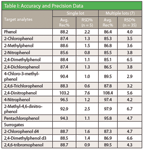Determination of Phenols in Drinking Water by Solid Phase Extraction and GC–MS
US EPA Method 528 determines 12 phenols in finished drinking water using solid phase extraction (SPE) and GC–MS detection.
US EPA Method 528 determines 12 phenols in finished drinking water using solid phase extraction (SPE) and GC–MS detection. Among the 12 phenols, 10 are listed as priority pollutants by the US EPA, the two exceptions are 2-methylphenol and 4-chloro-3-methylphenol. UCT has developed a new polystyrene divinylbenzene material for EPA Method 528. One liter of drinking water sample is passed through the SPE cartridge using a large sample delivery tube. The retained phenols are eluted with dichloromethane (DCM). A drying cartridge packed with anhydrous sodium sulfate is attached to the end of the SPE cartridge in the elution step, eliminating the separate eluate drying step.

SPE materials
SPE Procedure
a) De-chlorinate 1 L of drinking water sample with 40–50 mg sodium sulfite if free chlorine is present, then acidify the sample to pH ≤ 2 with 6 N HCl.
b) Spike with appropriate amounts of surrogates, and target analytes for fortified samples.
c) Connect the large sample delivery tubes to the top of the SPE cartridges (ECHLD156), and attach the cartridges to a SPE manifold.
d) Wash the cartridges with 3 aliquots of 3 mL DCM. Condition the cartridges with 3 aliquots of 3 mL methanol. Do not let the sorbent go dry after applying the third aliquot of methanol. Equilibrate the cartridges with 3 aliquots of 3 mL of 0.05 N HCl. Add ~3 mL 0.05 N HCl to the cartridge.
e) Insert test tubes or glass vials into the manifold, rinse the sample containers with 8–10 mL of DCM and use the large sample delivery tubes to pull the solvent through the cartridges slowly. Remove the tubes and add an additional 2–3 mL of DCM to the cartridges. Elute dropwise and collect.
f) Remove the sample delivery tubes from the SPE cartridges and dry the cartridges under full vacuum for 15 min.
g) Attach the drying cartridges (ECSS15M6) to the end of the SPE cartridges with cartridge adaptors (AD0000AS).
h) Insert test tubes or glass vials into the manifold, elute the SPE cartridges with 5 mL DCM, and repeat with sample bottle rinse of 10 mL DCM.
i) Concentrate the eluate to between 0.7 and 0.9 mL under a gentle stream of nitrogen at 35 °C. Add internal standards and adjust final volume to 1 mL with DCM.
j) The samples are ready for GC–MS analysis.

Table I: Accuracy and Precision Data
Instrumental
GC–MS: Agilent 6890N GC with 5975C MSD Injector: 1 µL splitless injection at 200 °C
Liner: 4 mm splitless gooseneck liner with deactivated glass wool (GCLGN4MM)
GC column: Restek Rxi®-5sil MS 30m*0.25mm*0.25 µm with 10 m guard column
Carrier gas: Helium at a constant flow of 1.0 mL/min
Temperature program: Initial temperature of 40 °C, hold for 6 min; ramp at 8 °C/min to 250 °C.
Solvent delay: 10 min
Tune: dftpp.u
Full Scan: 45–350 amu
Conclusion
Excellent analyte recoveries ranged from 85.1 to 108.4% with minimum lot-to-lot variations (< 10%) were achieved using UCT's new polystyrene DVB sorbent for phenols in drinking water.

UCT, LLC
2731 Bartram Road, Bristol, PA 19007
tel. (800) 385-3153
Email: methods@unitedchem.com
Website: www.unitedchem.com

Separation of Ultra-Short and Long Chain PFAS Compounds Using a Positive Charge Surface Column
December 11th 2024A separation of ultra-short and long chain PFAS (C1-C18) is performed on a HALO®PCS Phenyl-Hexyl column along with a HALO®PFAS Delay column which demonstrates excellent retention for both hydrophilic and hydrophobic analytes.

.png&w=3840&q=75)

.png&w=3840&q=75)



.png&w=3840&q=75)



.png&w=3840&q=75)














